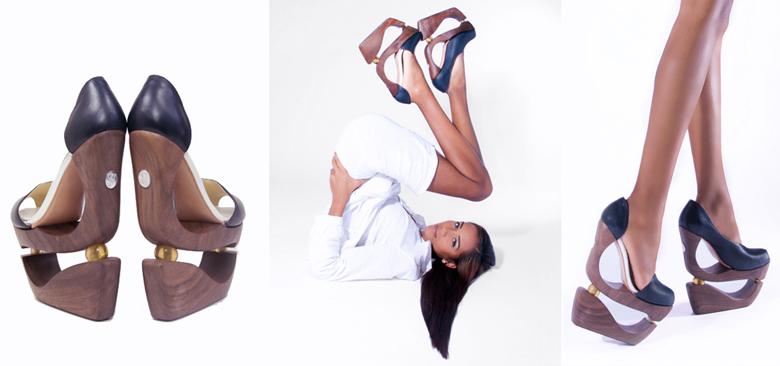With the aim of improving comfort without sacrificing glamour, Silvia Fado has dedicated herself to developing a mechanism which makes walking in heels easier.
Who is Silvia Fado and what is she doing in London?
I am a designer from Barcelona and I came to London to specialise in footwear. Why London? Besides the obvious reasons that it is a city full of inspiration and opportunity, because it has one of the best academies for footwear design, where during my Master’s program I learnt to make a pair of shoes from start to finish. I can honestly say that it has been an enriching experience. I decided to change tack three years ago, in order to follow my dreams, and these dreams have lead me here.
The collection that you have created draws attention to the technical complexity of using a spring system, with weight regulators. Are your shoes comfortable to walk in, or are they only for the catwalk?
The original idea was to develop a system which made walking in heels more comfortable. Some of the prototypes have stayed true to this, yet others were designed to push the concept, even where this meant compromising their functionality.
Are you going to use this model to create a high-street range, or do you see your work confined to catwalk fashion?
As far as I am concerned, the aim of any collection is to be sold. And so it is important to be able to adapt the designs according to the needs of the public, although I also believe that it is worth creating items which are more daring and conceptual, in order to have a high impact on your audience: my reply would be a mix of the two. One works as a point of departure whilst the other is a way of reaching the consumer. Photos courtesy by Silvia Fado
What was it like working with engineers and architects to create a shoe? Visually, the effect is very striking.
It was great to sound out ideas and then to have them expanded and improved upon. They were really very professional and ready to help, I never heard “no” for an answer and this is incredible for a designer.
Did the idea of making more comfortable high heels come from your own experience of wearing them?
Well, in a way, yes. I think that it was more a mix of my own experience and the desire to take shoes in a new direction, to develop a project which was rooted in functionality and in maximum comfort, so that the design could be guided by the needs inherent to footwear.
The items that you have designed don’t look like they’d be cheap. Do you envisage marketing them, and if so, who would be your investors?
In my most recent collection, “Kinetic Traces”, I present a concept which could be adapted and developed commercially by changing the construction process and tweaking the designs. The collection itself was created for exhibit only, and comprises of artworks whose parts are made by hand or by nothing but superior, high quality materials. This results in elevated manufacturing costs which could change a lot if they were produced on an industrial level, which is something I haven’t yet considered. For the project I’ve had a range of sponsors, from people (such as Jaime Fadó) to companies who have contributed to parts or materials (like MECMAN Ltd. and DisArt Ltd. Photos courtesy by Silvia Fado
What is your next project?
Well, after a year of hard work it’s now time to exhibit the product which so much effort has been put into creating. For the time being I am focusing on my contacts, the press and networking. I would like to do some collaborative work or to gain some professional experience for a while before I undertake anything independently.
With whom would you like to collaborate?
With some womenswear designer who already has an established range, whose aesthetics complement my work, who uses clean, minimalist lines, and who prioritises modernity and development.
Who would you like to see wearing your shoes?
Well, any woman who knows how to wear them stylishly and who feels beautiful in them. I don’t think that it’s the who that is important, but the how.
Who are your idols? Who has inspired you?
I have always been interested in intelligent and functional designs and this was the aim of my Master’s project. To achieve it I did a lot of research into architecture, engineering, machinery, jewellery, old watchmaking… and obviously looked at the influences of these on fashion. I would probably stress the work of Muybridge, a photographer who inspired me to analyse movement, or the watchmaking of the 20th Century, where you can see everything as it happens inside the mechanism itself, or the basic concepts of architectural engineering which I used to actually create the structures. I also looked at sports’ footwear and at the huge development in impact science and materials.
Do you envisage breaking into different strands of fashion design?
Not for the time being, but maybe in the future. You never know.
Photos courtesy by Silvia Fado
– – – – – – – – – – – – – – – – – – – – – – – – – –
If you want to see her collection and learn more about Silvia Fado, this is her Web: www.silviafado.com
More info: http://showtime.arts.ac.uk/SilviaFado

